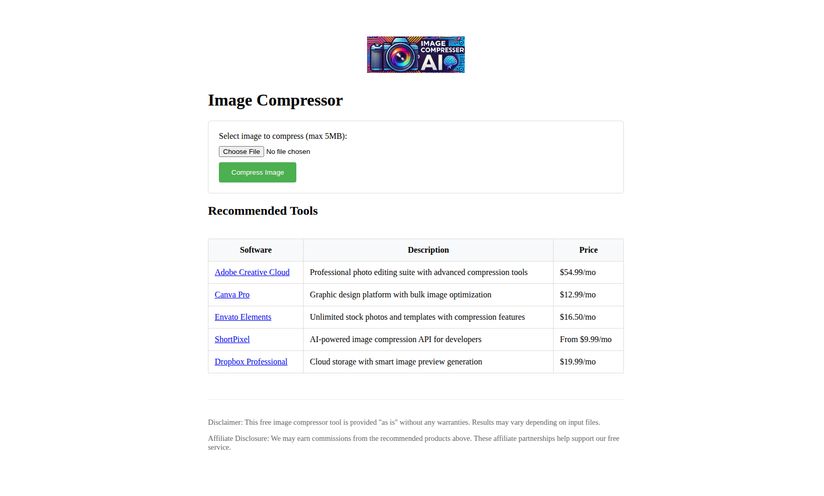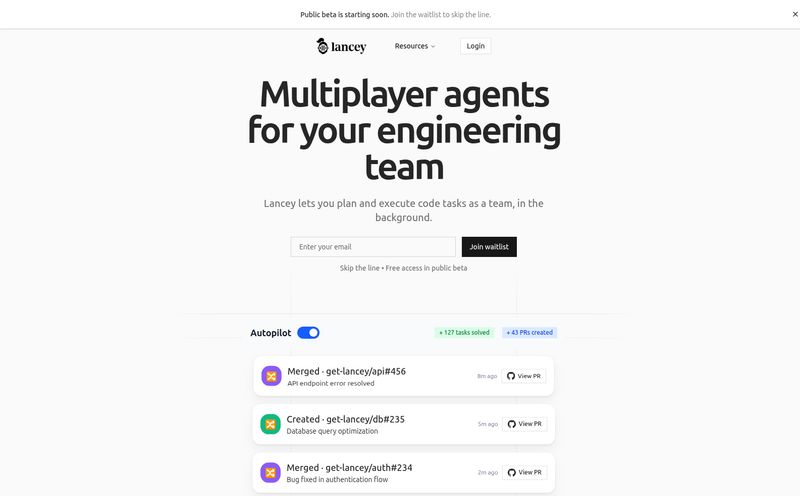How many times have you signed up for a new, all-singing, all-dancing project management tool, only to feel completely overwhelmed within a week? You spend more time learning the software—with its Gantt charts, custom automations, and a million sub-menus—than you do actually doing the work. It feels like you need a project manager just to manage your project manager. I've been there. My team has been there. It’s a special kind of productivity hell.
For years, the industry has been in an arms race. More features! More integrations! More complexity! But what if the solution isn't more, but less? What if you just need a clean, simple space to know what needs doing, who’s doing it, and when it’s due?
This is the exact itch that Todobee seems to be scratching. It popped up on my radar recently, and I have to admit, I was skeptical at first. Another to-do app? Groundbreaking. But the more I looked into it, the more I realised it might just be the breath of fresh air so many of us in the SEO and small business world have been desperately needing. So, I took a closer look.

Visit Todobee
So, What's the Big Deal with Todobee?
At its heart, Todobee is a minimalist project management app. It’s not trying to be the one tool to rule them all. It’s not built for massive corporations with labyrinthine hierarchies. It's designed specifically for solo operators, freelancers, and small teams who want to get things done without the bloat. Think of it less like a cluttered Swiss Army knife and more like a perfectly weighted chef's knife—it does one thing, and it does it beautifully.
But here’s the part that really got my attention. It’s customer-funded. This isn't just a feel-good marketing line. It means there are no venture capitalists breathing down their necks, demanding features that look good in a pitch deck but are useless in practice. Their development is driven by what actual users, people like you and me, say they need. That’s a fundamentally different approach, and one that builds a huge amount of trust from the get-go. They're building a tool for their customers, not for an exit strategy. A novel concept in 2024, I know.
The Features You'll Actually Use
Todobee’s feature set is all about focused execution. There’s no fluff here. Every tool serves a clear purpose in getting you from “to-do” to “done.”
Simplicity as a Superpower
The user interface is clean. Almost shockingly so. If you’ve ever opened Asana or Jira for the first time and felt a wave of anxiety, Todobee will feel like a calm meditation. Organizing tasks is as simple as dragging and dropping. Setting due dates, assigning tasks—it’s all intuitive. There’s virtually no learning curve, which means you can onboard your team (or just yourself) and be productive in minutes, not days.
Unlimited Everything. And I Mean Everything.
This is where things get a bit wild. Most project management tools gatekeep their features. You get a certain number of users or projects on one plan, and then you have to pay more. Todobee throws that model out the window. Every plan comes with unlimited users, unlimited projects, and unlimited sub-tasks. For small agencies or growing teams, this is massive. You never have to worry about your subscription cost ballooning just because you hired a new contractor or took on a new client. It’s liberating.
A Smart Look with the AI Progress Dashboard
Okay, “AI” is a term that gets thrown around a lot. In Todobee, it's not some sentient robot taking over your job. It's a smart dashboard that gives you a quick, visual overview of how projects are progressing. It helps you spot bottlenecks and see momentum without having to manually sift through dozens of tasks. It’s a genuinely helpful, high-level view that saves you time and keeps everyone on the same page.
Analytics Without the Analysis Paralysis
Todobee provides detailed analytics and reporting, but again, in a way that’s actually useful. You can easily track team performance, project completion rates, and other key metrics. It’s enough data to make informed decisions, but not so much that you get lost in a sea of spreadsheets. It answers the important questions: “Are we on track?” and “Where can we improve?”
The Pricing Model That Breaks the Mold
Alright, let’s talk about the elephant in the room. The price. When I first saw it, I thought it was a typo. The value here is, frankly, insane, and it’s probably Todobee’s single biggest selling point. They have two straightforward plans:
| Plan | Cost | Features |
|---|---|---|
| Monthly Plan | $39 / month | Unlimited Users, Projects, & Subtasks, AI Dashboard, Premium Support, and everything else. |
| Lifetime Deal | $299 one-time | All the same features as the monthly plan, forever. Yes, forever. |
Let that sink in. For a one-time payment of $299, you get a project management tool for your entire team, forever. Some competitors charge more than that per user, per year. This pricing strategy aligns perfectly with their target audience: small businesses and freelancers who need to watch their cash flow. It’s an investment, not a recurring expense sucking your bank account dry. This is a game-changer for budget-conscious teams.
Who Should Be Using Todobee?
Todobee has a very clear ideal customer. You'll love it if you are:
- A freelancer or solopreneur juggling multiple clients and projects.
- A small agency (think marketing, design, or development) that needs a central hub for tasks without the corporate overhead.
- A startup that needs to stay lean and agile, focusing resources on growth, not software subscriptions.
- Anyone who has ever looked at a complex PM tool and thought, “I just need a better to-do list!”
Conversely, it’s probably not the right fit if you’re a large enterprise needing complex, department-spanning workflows, resource management, or deep, native integrations with software like Salesforce or SAP. And that’s okay. Todobee knows who it’s for, and more importantly, who it isn’t for.
The Honest Downsides (Because Nothing's Perfect)
No review is complete without looking at the potential drawbacks. Based on my analysis, there are two things to keep in mind.
First, the integrations are limited. You’re not going to find a massive marketplace of apps to plug in. For some, this is a dealbreaker. For the target audience, it's often a blessing. It forces a simpler workflow and avoids the tangled mess of dependencies that can bring a project to a halt. It’s a focused tool, not a central command center for your entire tech stack.
Second, it lacks some advanced, niche features. You won’t find time-tracking built-in (though you can manage that separately) or super-detailed Gantt charts. But again, this is by design. The entire philosophy is to remove the features that 90% of users never touch anyway. It’s a conscious trade-off of niche power for everyday usability.
Frequently Asked Questions About Todobee
What makes Todobee different from Trello or Asana?
The main difference is philosophy. Trello is great for visual card-based workflows and Asana is a powerhouse of features. Todobee sits in a sweet spot, offering more structure than a simple Kanban board but without the overwhelming complexity of a tool like Asana. Plus, its pricing model of unlimited users is a major differentiator.
Is the lifetime deal for real? What's the catch?
It seems to be very real. The "catch" isn’t a hidden fee, but a strategic choice. By offering a lifetime deal, Todobee secures upfront cash flow to fund its customer-driven development and builds a loyal user base. The risk for the user is minimal, especially compared to paying a monthly fee indefinitely.
Can I use this just for my personal to-do lists?
Absolutely. It’s a fantastic tool for personal project management, organizing life goals, or even planning a big event. The clean interface makes it great for individual use, and you'll just happen to have the power to add collaborators if you ever need to.
What does 'customer-funded' really mean for me?
It means the features that get built are the ones users are actually asking for. The company’s success is directly tied to making its existing customers happy, not to chasing the next round of funding. You're less likely to see sudden, unwelcome changes or price hikes designed to please investors.
Is it actually easy to use?
Yes. Of all the project management tools I've tested over the years, this is one of the most straightforward. The learning curve is practically flat. If you can use a basic notes app, you can use Todobee.
My Final Take: Should You Get on the Todobee Train?
After spending time with Todobee, I’m genuinely impressed. It’s not just another app; it’s a statement against the feature-creep that plagues the software industry. It’s a tool built with a clear purpose and a refreshing respect for the user's time and intelligence.
If you're a solo operator or running a small team and you feel like you're drowning in complexity, Todobee is more than worth a look. It offers the core functionality you need in a clean, fast, and intuitive package. And with that pricing—especially the lifetime deal—it’s not just a good tool, it’s an incredible value. It might just be the simple, powerful solution you’ve been looking for to finally get organized and get back to doing what you do best.



